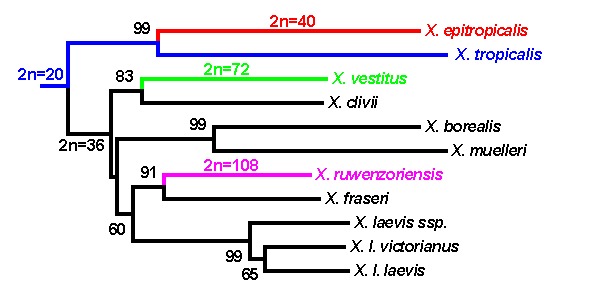

Molecular Phylogeny of African Clawed Frogs (Xenopus: Pipidae)
Speciation by auto- & alloploidy


Analysis of
mitochondrial DNA clarifies karyotypic evolution within the
genus Xenopus (Pipidae). Xenopus
comprises two clades. The first (the Silurana group)
comprises X. tropicalis, which has retained the
ancestral diploid number for pipid frogs (2n=20, also
seen in the related genus Hymenochirus), and X.
epitropicalis, which has undergone polyploidization
(2n=40). The second clade (the Xenopus
group) comprises the remaining species of the genus, and has
undergone an independent polyploidization, such that all
species share a modified tetraploid (2n=36)
karyotype or euploid multiples thereof. Within this clade, tetraploid
species X. muelleri and X. borealis are
sister species, the octaploid (2n=72) X.
vestitus is most closely related to X. clivii,
and the dodecaploid (2n=108) X. ruwenzoriensis is most closely
related to X. fraseri.
The evolution of allo- or autopolyploid species were examined by SM Carr et al. (1986). The strong morphological resemblance of epitropicalis and ruwenzoriensis to their respective sister species indicates that both the maternally-inherited mtDNA and the dominant nuclear alleles influencing morphology are derived from the same species, possibly by autopolyploidy. On the other hand, the close mtDNA affinities of vestitus to clivii, which is morphologically more similar to borealis or muelleri, suggests an allopolyploid origin. Finally, ruwenzoriensis is a cryptic species that is almost indistinguishable from fraseri, which suggests an origin by allo-triploidy, possibly with laevis.
[The top figure shows a neighbor-joining analysis of 1429bp
from the mitochondrial Cytochrome b, Cytochrome Oxidase
subunit I, & 12S rDNA genes; numbers associated with each
branch point indicate the occurrence of each clade in 1000
bootstrap replications. Similar results are obtained with
parsimony & likelihood analyses].
[The bottom figure shows mating by pelvic amplexus. The
smaller male frog approaches the larger female from behind and
above, and grasps her in front of her pelvis. This places
their genital openings in close proximity, and allows him to
fertilize her eggs as they are extruded. Reproductive behavior
is inducible in the lab by injecting males and females with
gonadotropic hormones, which stimulates oogenesis in females
and spermatogenesis in males. Under lab conditions, male frogs
are not choosy: the third frog in the chain has grasped the
second, a male].